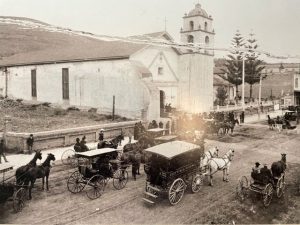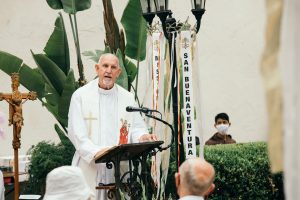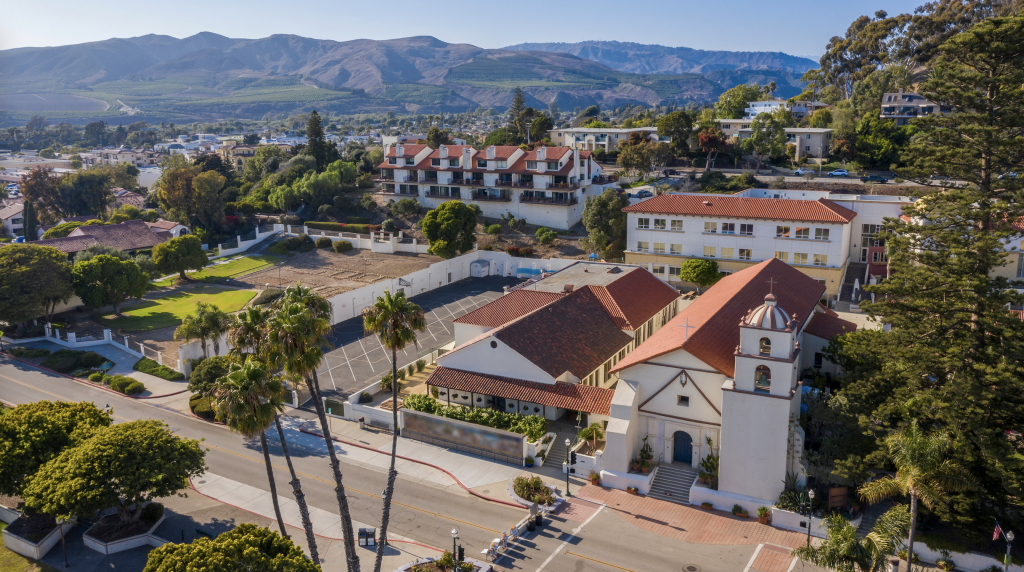Beneath a 99-year-old building at Mission Basilica San Buenaventura lies an abandoned cemetery with the remains of about 3,000 Chumash Catholics who died between the mission’s founding by St. Junípero Serra in 1782 and the mid-19th century.
Now, the pastor of the mission is working with Chumash leaders and an archeologist to identify and commemorate the dead.
It is “time to formally address this as a point of reconciliation and healing with the Chumash people,” said the pastor, Father Tom Elewaut.
In 1862, with the cemetery at capacity, all headstones and the remains of perhaps 1,000 people were transferred to a new cemetery. But most of the Chumash had been buried without coffins, wrapped in cloth, which was their tradition. After decades, their remains were impossible to detect and were not recovered, he said. In 1922, the mission built Holy Cross School over the cemetery, a building that now serves as parish offices.
For the Chumash, those graves represent many losses inflicted on their people as a consequence of Spanish colonization — loss of homes, loss of lives and loved ones, loss of culture, loss of respect.
“I will be 65 this year. The people coming up behind me in their 30s and 40s are very vocal about the intergenerational trauma and why they don’t know about, why they didn’t grow up in, this place of pride in their heritage,” said Julie Tumamait-Stenslie, chairperson of the Barbareño-Ventureño Band of Mission Indians.
In addition to being a Chumash traditional singer and artist, she is certified to monitor construction sites for indigenous archaeological finds. She also advises universities and other institutions on the repatriation of such artifacts. For her, the buried cemetery is like an open wound.
Tumamait-Stenslie believes the Chumash buried there were deprived of the rites of their people, who held that the soul lingers after death to bid farewell in dreams and visions, then shoots like a comet into the western sky. Did anyone sing them into the next life — with prayers to remember their loved ones — as the mission now allows her to sing when Chumash Catholics have been lowered into their graves?

As for those transferred to the new cemetery in 1862, “I wonder if they were just dumped,” she said.
Father Elewaut is similarly disturbed that the church built over the cemetery. “I don’t know how they could not have known it was there,” he said.
Shortly after he was assigned to the mission in 2011, someone contacted him demanding the demolition of a building that stood over a Chumash burial site.
“I had no idea what they were talking about, but I promised to look into it,” he said.
He found it was true. The cemetery troubled him until, in summer 2020, he had an opportunity to speak at a protest by Indigenous people who wanted a statue of St. Junípero Serra removed from the Ventura City Hall. They viewed St. Serra as a racist, responsible for the deaths of countless native people.
While he and Tumamait-Stenslie have very different interpretations of the mission period, Father Elewaut acknowledges the unhealed wounds and continued suffering of the Chumash.
Identifying and commemorating the dead is “an opportunity for recognition and healing that won’t just ignore what happened,” he said.
Father Elewaut believes the history of the missions and the Indigenous people is complex, and that Serra deserves sainthood in part for his heroic efforts to protect Native Americans from abuse by the military. When several speakers brought up the cemetery, he saw an opening for constructive action.
“I made a public proclamation that it was long overdue to have some form of recognition of them being buried on the grounds of this mission. I promised that before I leave my pastorate, I would work with the tribal chairperson to make sure that was accomplished,” he said.
Tumamait-Stenslie heard his promise. She had first met Father Elewaut in the mission garden as she burned white sage in an abalone shell for descendants of Spanish soldiers on pilgrimage to repent for the sins of their ancestors.
The priest had asked who she was. When she told him, she said, he let her proceed, explaining that he only allowed such ceremonies if the celebrants had permission from the Chumash. His intent was to respect the integrity of Chumash tradition and their relationship with the mission.
“I appreciate Father Tom. He recognizes that our families built that mission. Not by choice, but it is ours,” said Tumamait-Stenslie, who is not a practicing Catholic.
After his pledge, she connected him with Robert Lopez, professor emeritus of anthropology and archaeology at Moorpark College and archivist of the Ventura County Archaeological Society. He had spent decades studying the sacramental records of Mission San Buenaventura, and was digitizing them for genealogical use.
His work is invaluable because the Chumash had no written language, Tumamait-Stenslie said: “We have no written documentation other than the baptismal records.”
The sacramental books — penned in elaborate 18th century Spanish script — include baptisms, weddings, and burials. Early entries often had Chumash birth names, and sometimes a village of origin. Lopez has entered 4,330 individuals up to 1844, with an estimated 3,000 remaining. About half died and were buried at Mission San Buenaventura.
The records are enlightening because “they are connected to a mission and that mission absorbed predominantly one tribe,” Lopez said.
The Chumash might have become celebrated as one of the great peoples of America, had disease not decimated them. “The population for the Chumash was very high when the Spanish arrived. It diminished to just a few thousand individuals at the very end,” Lopez said.
Before colonization, the Chumash occupied 7,000 square miles along some of California’s most iconic coastline. Their territory extended inland about 40 miles from Malibu, stretching north past Point Conception and included the islands of San Miguel, Santa Rosa, Santa Cruz and Anacapa.
They prospered off land and sea, using harpoons to catch swordfish, with nets and lines for smaller fish, Lopez said. Their extensive trade routes included seafaring on wooden rafts. They exercised responsible governance, such as conserving game by not hunting deer during fawning season.
“They called themselves the People of the Big Rock,” Lopez said, referring to Mugu Rock.
“The Franciscans did not consider the Chumash savages,” he said. “They understood that they were dealing with a culture that was very advanced.”
One friar spoke fluent Chumash and wrote about their social structure. An aspect he missed was that tribal status was inherited through mothers, not fathers.
“Unfortunately, they didn’t understand that the Chumash were a matrilineal society. If they had, they would have asked the names of the women,” he said, noting that mothers were often omitted in the records.
The friars also did not understand that they carried diseases that they could resist, but the Chumash could not. No matter what one thinks of their methods, “their intent was to teach the people, not to kill them,” Father Elewaut said.
But as the Chumash died, traditions died with them. Stories and rituals were randomly preserved by individuals who practiced them in secret. Many Chumash beliefs about death are lost or unclear, Tumamait-Stenslie said.
What is clear is that burial sites are robbed for bones, jewelry, tools, and other items buried with the Chumash.
“There is a market in selling artifacts from these graves,” she said.

Tumamait-Stenslie and Father Elewaut believe that the memorial project will restore respect for the dead and some sense of connection to their descendants.
They envision a digitized list of the dead and their family relationships, as well as a monument. Tumamait-Stenslie intends to consult widely about the memorial design, not only with her own band but other Chumash groups and individuals who have left the region.
“It’s not just my family that’s buried there, so it’s not just my decision,” she said. “Maybe it will be some sort of art form. I personally would like to see the names of our people, which are beautiful in our language.”
Father Elewaut hopes that restoring the names will help to convey the missionaries’ desire to recognize and minister to the Native Americans.
“Despite the negative things that happened, something good has come because the Church kept accurate, detailed, records,” he said. “This gives the history, the ancestry, of Indigenous people for whom there otherwise would be no records.”

